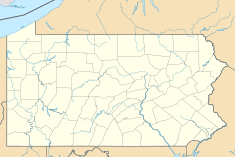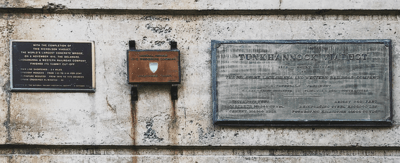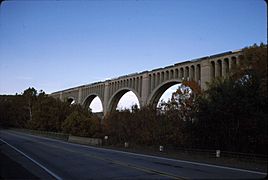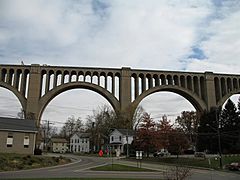Tunkhannock Viaduct facts for kids
Quick facts for kids Tunkhannock Creek Viaduct |
|
|---|---|
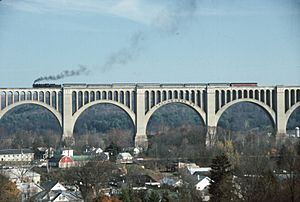
A Steamtown National Historic Site excursion train crosses Tunkhannock Viaduct.
|
|
| Carries | railroad traffic |
| Crosses | Tunkhannock Creek |
| Locale | Nicholson, Pennsylvania, U.S. |
| Characteristics | |
| Design | Deck arch bridge |
| Material | concrete |
| Total length | 2,375 feet (723.9 m) |
| Longest span | 180 feet (54.9 m) each span |
| Number of spans | 10 (11 piers) |
| Clearance below | 240 feet (73.2 m) |
| History | |
| Designer | Abraham Burton Cohen |
| Construction begin | May 1912 |
| Opened | November 6, 1915 |
|
Tunkhannock Creek Viaduct
|
|
| Area | 3 acres (1.2 ha) |
| Built | 1912-1915 |
| NRHP reference No. | 77001203 |
| Significant dates | |
| Added to NRHP | April 11, 1977 |
The Tunkhannock Creek Viaduct is a huge concrete arch bridge in Nicholson, Pennsylvania. It is also known as the Nicholson Bridge. This amazing structure carries railroad tracks over Tunkhannock Creek.
When it was finished in 1915, it was the largest concrete structure in the world! Even 50 years later, it was still called "the largest concrete bridge in America, if not the world." It is 2,375 feet (724 m) long and stands 240 feet (73.15 m) above the creek.
The Delaware, Lackawanna and Western Railroad (DL&W) built this bridge. Today, the Norfolk Southern Railway owns it. Trains still use it every day to carry freight.
Building a Giant Bridge
The DL&W railroad built the Tunkhannock Viaduct as part of a new train route. This new route, called the Nicholson Cutoff, was 39.6-mile (63.7 km) long. It helped trains avoid a winding and hilly section of track. This saved about 21 minutes for passenger trains and an hour for freight trains!
Who Designed and Built It?
The bridge was designed by Abraham Burton Cohen from the DL&W railroad. Other important people from the DL&W included G. J. Ray, the chief engineer, and F. L. Wheaton, the construction engineer. C. W. Simpson was the engineer in charge of building it.
The company that actually built the bridge was Flickwir & Bush. Their general manager was F. M. Talbot, and W. C. Ritner was the superintendent.
Starting Construction
Work on the bridge began in May 1912. Workers had to dig down very deep to find solid rock for the bridge's foundations. Some of these foundations, called piers, went down 138 feet (42 m) underground!
A huge amount of material was dug out for the viaduct. They removed 13,318,000 cubic yards (10,182,000 m3) of dirt and rock. More than half of that was solid rock!
How Much Material Was Used?
Almost half of the bridge's total size is actually hidden underground. During construction, 80,000 cubic yards (61,000 m3) of concrete went into the parts below the ground.
In the end, the bridge used about 167,000 cubic yards (128,000 m3) of concrete. It also used 1,140 short tons (1,030 t; 1,020 long tons) of steel. This made the bridge weigh around 670,000,000 pounds (300,000,000 kg)!
When the Bridge Opened
The Tunkhannock Viaduct was officially opened on November 6, 1915. This was also the day the entire Nicholson Cutoff train route opened for use.
A Recognized Landmark
The Tunkhannock Viaduct is a very important structure. It has received several special recognitions.
Historic Civil Engineering Landmark
In 1975, the American Society of Civil Engineers (ASCE) named the bridge a Historic Civil Engineering Landmark. This means it's a very important example of engineering. The ASCE noted that it was the largest reinforced concrete railroad bridge ever built when it was constructed.
They also said the bridge was not just a great building achievement. It was also a brave and successful new way to plan railroad routes. It helped trains cross the land in a way that greatly reduced distance and steep hills. At the time, engineers didn't have much experience building with reinforced concrete for railroads.
National Register of Historic Places
The bridge was also added to the National Register of Historic Places on May 3, 1977. This list includes important historical places in the United States.
Local Celebrations
Since 1990, the town of Nicholson has celebrated the bridge every year. They have a "Nicholson Bridge Day" on the second Sunday of September. It includes a street fair, a parade, and other fun activities. In September 2015, they celebrated the bridge's 100th birthday!
Gallery


